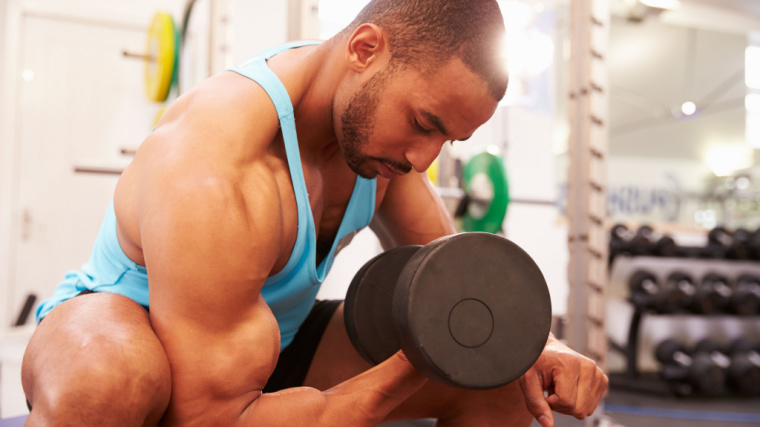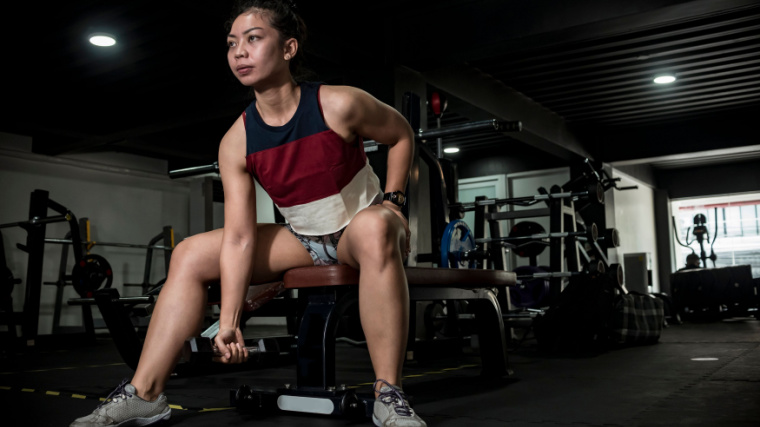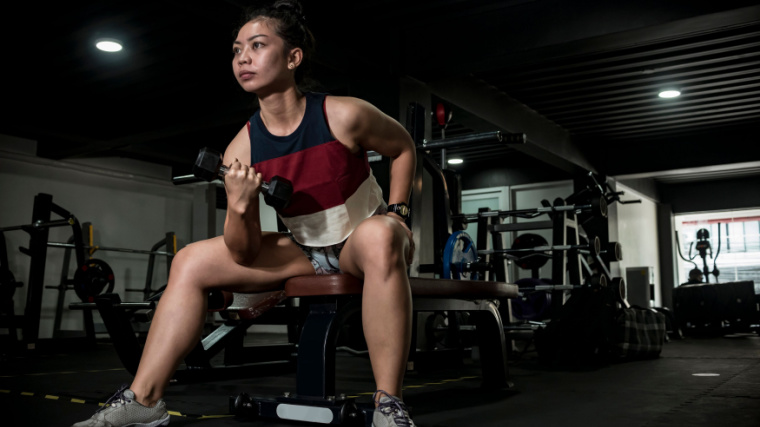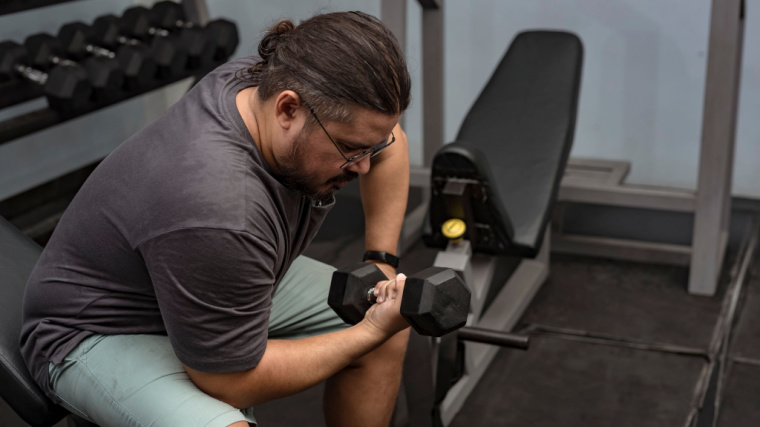If you pick up dumbbells with the intention to curl them, you might have big, bulging biceps on your mind. Chasing the pump for the sake of rounder bis is common in the weight room. There are a lot of different kinds of curls that can help get you there — the concentration curl is a particularly effective biceps muscle-builder.
Even if you’re not focused on a particular aesthetic, strong biceps play a critical role in your training. Your biceps assist everything from pull-ups and chin-ups to lat pulldowns and all kinds of rows. If you want a strong back, solid biceps help you get there. Once again, enter the concentration curl.

Concentration curls take — you guessed it — a fair amount of concentration to keep your form locked in and all the energy focused on your actual biceps. But it’ll be well-worth the effort. The positioning of concentration curls gives your biceps under direct, isolated attention. And the more specific attention you can give to your arms, the more likely you are to be able to make them pop.
- How to Do the Concentration Curl
- Concentration Curl Sets and Reps
- Common Concentration Curl Mistakes
- Concentration Curl Variations
- Concentration Curl Alternatives
- Muscles Worked by the Concentration Curl
- Benefits of the Concentration Curl
- Who Should Do the Concentration Curl
- Frequently Asked Questions
How to Do the Concentration Curl
Performing the concentration curl may look easy — and, to an extent, it is. Just make sure you’re setting it up properly, or you’ll miss out on the muscle-building perks.
Step 1 — The Set-Up

Sit on the edge of a weight bench with your knees far apart from each other. Grasp a dumbbell in your left hand. Hinge forward with your spine neutral. Brace your upper arm — your triceps — against your left inner thigh.
If you need more room to accommodate your stomach and/or chest, lean further forward to brace your upper arm against your inner left calf or shin. The goal is to get your upper arm as perpendicular to the ground as possible. Elevate your right foot on a bumper plate or step if you need to give yourself extra room.
Coach’s Tip: Try to avoid wedging your elbow into your knee. That will allow you to use your leg as leverage to lift more weight, which will take away emphasis from your biceps.
Step 2 — Curl

Prepare for your curl by bracing your core and tightening your glutes. Squeeze your (empty) right hand and hold it out away from your body to counterbalance yourself. You can also grip your right knee or the weight bench on your right side.
Curl the weight up, focusing on using only your biceps to do so. Hold a strong contraction for a beat at the top of your range of motion, keeping your upper arm stable the whole time.
Coach’s Tip: Press your feet down into the ground throughout the lift to stabilize your body. The more stable the rest of your body is, the more isolation you’ll be giving your biceps.
Step 3 — Lower With Control

After holding for a moment at the top, lower the weight with slow control. Let your arm straighten to full extension, which may mean letting the back of your wrist graze your ankle or lower calf.
Re-establish tension and repeat for reps. Keep your reps even on both sides.
Coach’s Tip: Avoid rushing through the lowering phase of this lift. You don’t want gravity to yank the weight down — resist it as much as possible.
Concentration Curl Sets and Reps
You’re not going to be using this lift to max out, but you can still use it to strengthen your biceps pretty significantly. Depending on your exact goals, you’ll use relatively lighter or heavier weights. No matter what your goal is, though, make sure you’re using enough weight to be challenging but not so much that you lose your form.
- For Strength: Do three to four sets of six to eight reps per side.
- For Muscle: Perform three to four sets of eight to 12 reps per side, approaching failure with each set.
- For Endurance: With a relatively light — but still challenging — weight, do three to four sets of 15 to 20 reps.
The positioning of this exercise is great for allowing yourself to hit failure with relative safety. However, make sure that you’re not compromising your form as the move gets harder with each passing rep.
Common Concentration Curl Mistakes
Some of the biggest concentration curl mistakes begin before you even move the weight. Learn about these key lifting mistakes so you can avoid them on the floor.
Elbow Positioning
It’s tempting to wedge your elbow into the crease of your knee — you might even see other athletes doing it, or have been coached to do it yourself. And while the old wedge-your-elbow technique might get you to heft more weight, it won’t help you use more of your biceps.
But jamming your elbow into the stable nook between your upper and lower leg, you’re giving yourself more leverage — which is actually not what you want in this context. You’re trying to isolate your biceps as much as possible, and wedging your elbow into your knee crease will do the opposite.

Instead of recruiting support from your leg angle, press your triceps into your inner thigh (or straight across your lower leg if needed). That way, your biceps will be forced to do all the actual work.
Curling Too Much
Yes, this is a curl — but yes, you can have too much of a good thing. It’s tempting to “finish the curl” hard and strong, but doing so can actually defeat the purpose. If you’re trying to muscle the dumbbell all the way up to your shoulder, you’re likely wasting precious energy.
Stop the curl once your triceps starts losing touch with your leg, or once your upper arm stops being perpendicular to the ground. That way, you’ll be performing only a high-quality contraction without forcing an arbitrary range of motion that won’t maximize your biceps recruitment anyway.
Too Much Weight
If you feel like you need to wedge your elbow or you just won’t be able to get the weight up, you’re probably using too much. Similarly, if the dumbbell comes crashing down with little control during the eccentric phase of the lift, it’s too heavy.
Using a manageable weight will allow you to maintain excellent form, which in turn will let you keep maximum focus on your biceps. The appeal of the concentration curl is how well it isolates your biceps — so make sure you’re using a weight that allows you to do that effectively.
Concentration Curl Variations
Once you’ve successfully added the concentration curl to your repertoire, you might want even more. No problem. Here are some concentration curl variations to vary up your curling.
Standing Concentration Curl
When you’re performing the standard seated variation of this lift, you’ll be in a supported hip hinge. In the standing concentration curl, however, your hinge will have a lot less support.
You’ll still be isolating your biceps in terms of your upper body engagement. However, you’ll be adding tension and perhaps even a good strong stretch to your hamstrings and glutes, too. If you need more practice holding an isometric hinge, this is a good place to get it.
Cable Concentration Curl
Dumbbell concentration curls offer a whole lot of muscle-building potential. Performing this same move with cables can increase your potential for muscle growth even further.
That’s because the tension from the cable will provide consistent resistance throughout your range of motion. This will add up to more time under tension, which is a great recipe for building thicker muscles.
Hammer Concentration Curl
If you’re looking to get the most out of the long head of your biceps, the hammer curl has got your back — erm, arms. And if you want to isolate your biceps long head as much as possible, do this move concentration-style.
With a hammer curl, you maintain a neutral grip — palms facing toward your body’s midline, like you were holding a hammer — throughout your reps. When you do this during a concentration curl, you take the isolation nature of this move and combine it with a long head emphasis.
Concentration Curl Alternatives
Even with adjustments, the concentration curl may not work comfortably for every lifter’s body. If that’s the case — or if you’re simply looking to expand your repertoire — here are some concentration curl alternatives.
Incline Bench Hammer Curl
Once again, meet the hammer curl. This time, you’ll be performing hammer curls while sitting on an incline bench. This gives similar benefits as the concentration curl because your upper body will be anchored.
The added stability from bracing your upper body on an incline bench helps you isolate your biceps even more than the standing version. Just make sure you keep your shoulders relaxed and down.
Preacher Curl
The preacher curl is known for taking your arms to church. This move has you brace your upper arms over an incline bench, stabilizing your triceps while curling with your biceps.
By planting your upper arms on a bench, you’re taking your shoulders out of the curl. This leaves just the strength of your biceps (and forearms) to bring the weight up and down.
Spider Curl
Don’t worry — no actual arachnids are required for this one. The spider curl is similar to the preacher curl, except you’ll be supporting your entire upper body instead of just your upper arm(s).
With the spider curl, you’ll be getting maximal support so you can worry as little as possible about falling out of form. With such support, you’ll also be able to maximize your biceps recruitment, making your exercise extra specific.
Muscles Worked by the Concentration Curl
The concentration curl is an excellent example of a single-joint, isolation exercise meant to target one muscle. That said, no muscle is an island.
Biceps
Your biceps are the target muscle of the concentration curl and should always be the muscle that receives the most stimulus here. Both the long and short head of your biceps will work with the concentration curl. You can give your long head even more stimulus by altering your grip orientation to perform a hammer concentration curl.
Forearms
While they’re not the primary target of the move, your forearms will assist your biceps with the concentration curl. They’ll help keep your grip nice and steady and help you maintain a neutral wrist position throughout the movement.
Benefits of the Concentration Curl
The concentration curl carries a host of benefits. If you’re not convinced why you should add this biceps powerhouse to your routine, read on.
Bigger, Stronger Biceps
When you do it right, the concentration curl will help you bring a lot more strength and size to your biceps. Because you’ll be isolating your biceps and focusing on getting the most out of each contraction, your biceps stand to grow a lot from this move.
[Read More: The Best Upper Body Exercises and Workouts]
You’ll be forced to use excellent technique here, meaning that you won’t be able to cheat your biceps out of doing the work for themselves. This is an excellent recipe for muscle growth and strength.
Increase Biceps Isolation
Moves like chin-ups will help your biceps grow, too — but at a cost. Chin-ups are amazing at recruiting a lot of muscle mass from across your upper body and core. While that’s excellent news for strength and muscle mass overall, it’s not necessarily the best for targeting your biceps specifically.
The more you can isolate your biceps, the more you can target them for true muscle failure. And the closer they can get to that point, the more likely you are to stimulate significant muscle growth. By isolating your biceps from the rest of your body’s support, the concentration curl does exactly that.
Stronger Mind-Muscle Connection
Your biceps aren’t the only thing that the concentration curl can strengthen. You’ll be bolstering your mind-muscle connection, too. In order to perform concentration curls to the best of your ability, you literally have to concentrate.
[Read More: The Best Biceps Exercises for a Muscle-Building Workout]
Keeping perfect form for this lift might look simple, but there are a lot of moving pieces. You’ll need to maintain a very disciplined upper arm position and move very slowly in the eccentric to make the most of this lift. In doing so, you’ll get a lot of practice at building connections between your mind and body.
Who Should Do the Concentration Curl
From beginners to advanced competitive athletes, the concentration curl can be an appealing option to add to programming.
- Bodybuilders: The name of the game in bodybuilding is building quality muscle mass. Because the concentration curl is such a strong muscle-builder, it’s a great choice for bodybuilders looking to increase their focus on their biceps specifically.
- Powerlifters: Although powerlifters don’t need arm-specific exercises to compete, building a well-rounded set of muscles is an important part of developing max strength. Strong biceps are important for supporting powerful deadlifts and keeping your overall upper body strength balanced and optimized.
- Beginners: Some beginners may want to develop bigger, stronger arm muscles. The concentration curl can help in a big way. Even if someone isn’t concerned with aesthetics, strengthening your biceps can help you build up the strength you need to perform movements like chin-ups and pull-ups.
Wherever you fall in the training spectrum, if you want to get big arms, the concentration curl can likely help you out.
Concentrate on Gains
Biceps gains are top of mind for a lot of lifters. If you want your biceps to grow but they’ve reached a stagnant point, bring in the concentration curl to isolate your biceps and prime you for growth. You won’t need to worry about your shoulders overcompensating or your back strength taking over during this biceps move. Just focus on maintaining excellent form, work toward strong contractions, and you’re setting yourself up for big gains.
FAQs
Still have questions about how to use concentration curls to maximize your biceps gains? Here are some answers to the most common concentration curl questions.
How much weight should you use for concentration curls?
Concentration curls will isolate your biceps in a big way, since you’re bracing your upper arm against your thigh. Because of this, you may want to start several pounds lighter than you would for your usual dumbbell curls. Only move up in weight when you’re certain you’re proceeding without unnecessary momentum and excellent form.
Where should your elbows go with concentration curls?
Many athletes try to anchor their active elbow into their knee. Instead, brace your upper arm on your inner thigh or along your lower leg. Try to keep your upper arm as perpendicular to the ground as you can throughout the lift. Once you’ve found your starting position, try to keep it as still as possible, only moving through your forearm.
Are concentration curls or preacher curls better?
All things being equal, the battle of concentration curls versus preacher curls might be won by which feels more accessible to you.
The goal of both movements is to brace your upper arm so that you can isolate your biceps as much as possible. If you’re more comfortable with one type of curl over the other, you’re likely to perform them better. And when you perform an exercise better, it generally becomes the more effective one for you.
Featured Image: Monkey Business Images / Shutterstock